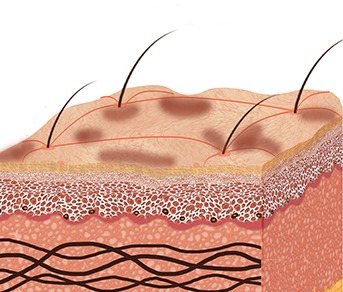Hyperpigmentation
Hyperpigmentation is a condition that occurs when the skin’s pigmentation becomes darker. It is the opposite of hypopigmentation, where your skin becomes lighter. Hyperpigmentation is more common for people with darker skin, and can last for months or years. It often manifests itself as dark patches on the skin or freckling and spots, but the different types of hyperpigmentation need to be understood because treatment is not always the same.
What is Hyperpigmentation?
Hyperpigmentation is the darkening of an area of skin or nails caused by increased melanin. Hyperpigmentation can result in flat, darkened patches of skin that can vary in size and shape but are generally light brown to black in colour. People with darker skin tones are more prone to hyperpigmentation, especially with excess sun exposure, but it can affect people with all skin tones.
There are many types of hyperpigmentation, but the most common are:
- Pigment spots caused by sun exposure. They appear mainly on body parts that are frequently exposed to the sun, such as the face, hands and arms and appear as small, darkened patches of skin.
- Melasma or chloasma. Often referred to as “the mask of pregnancy”, This form of hyperpigmentation is caused by hormonal changes which is why it affects the majority of pregnant women. Women who take birth control pills are also at risk of developing melasma because they cause changes in hormonal levels.
- Freckles appearing on the face. Although freckles are an inherited feature, they can become more prominent when exposed to sunlight.
Post-inflammatory hyperpigmentation can occur when a skin injury or trauma heals. For instance, acne marks may be left behind after pimples heal. This can leave a flat area of discolouration behind. Although commonly found among acne sufferers, it can also be caused by cosmetic procedures such as dermabrasion, chemical peels and laser treatment.
While hyperpigmentation can look alarming at times, it poses no health risk and is a cosmetic rather than a medical condition. None the less, it can still be a serious problem due to the emotional distress and self esteem issues it can cause for some people.
Signs of Hyperpigmentation

Signs of Hyperpigmentation
Hyperpigmentation is indicated by one or more of the following signs – freckling, age spots, or post-inflammatory hyperpigmentation (PIH). PIH can happen due to many different types of injury to the skin, from waxing to insect bites and chemicals in cleaning products.
It is most common on the face, arms and hands.
Causes of Hyperpigmentation
Hyperpigmentation can be caused by a number of factors, such as UV damage, melasma due to hormonal fluctuations, or as a result of skin injury, e.g. acne or laser treatment. Many of these factors are manageable, but some are unavoidable. Melasma, for instance, is common in pregnant women, and is often referred to as “pregnancy mask”.
Hyperpigmentation occurs in patches on the skin when the melanocytes, the cells which produce the melanin pigment, produce too much melanin due to over-activity.
Treatment of Hyperpigmentation

Treatment of Hyperpigmentation
One of the best ways to avoid Hyperpigmentation is to firstly limit exposure to the sun and protect your skin from the suns harmful UVA and UVB rays by wearing the appropriate level of sunscreen. Avoiding excessive trauma to the skin, e.g. by using less harsh chemicals in cleaning products can also help limit and manage Melasma.
However, when hyperpigmentation requires treatment, hydroquinone is recommended for treating age spots, dark spots and melasma, and is a key ingredient in Obagi’s Nu-Derm System.
Hydroquinone is a naturally occurring substance found in many fruits and grains. It acts upon the melanocytes, suppressing them in the affected area. It can take several weeks to see results from using treatments with hydroquinone, and it is strongly recommended that patients who have seen improvements in their pigmentation as a result of using Obagi Nu-Derm or the Obagi-C Systems use the appropriate sunscreen, such as Obagi’s Sun Shield Matte or Sun Shield Tint SPF50 as well as Obagi Physical UV Block to prevent hyperpigmentation returning. Exposure to the sun’s radiation can naturally cause significant changes to the skin’s pigmentation, so treatment is only part of the solution.
If hyperpigmentation is caused by acne or blemishes, Obagi Medical Products can help to greatly manage and reduce acne. If you have hyperpigmentation, speak to your skin care physician about how Obagi can help.
How Can We Help?
Healthxchange is a trusted supplier of pharmacy products to healthcare professionals and offer a range of treatments that can be used to help manage the appearance of hyperpigmentation.
Obagi Nu-Derm and Obagi C-Systems helps reduce the appearance of moderate to severe hyperpigmentation including Melasma.
To find a clinic near you offering these Obagi treatments, use our Clinic Finder.